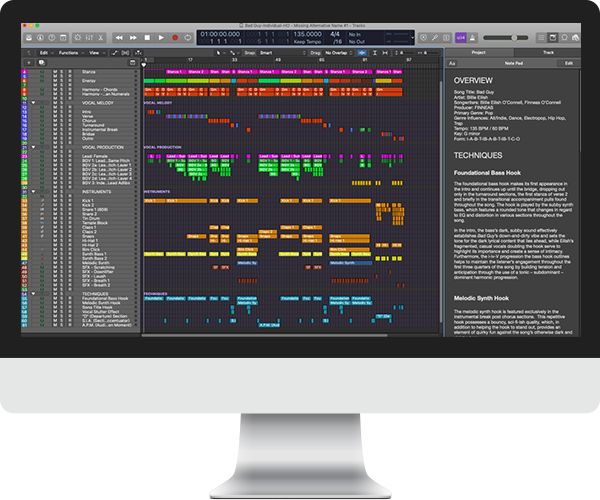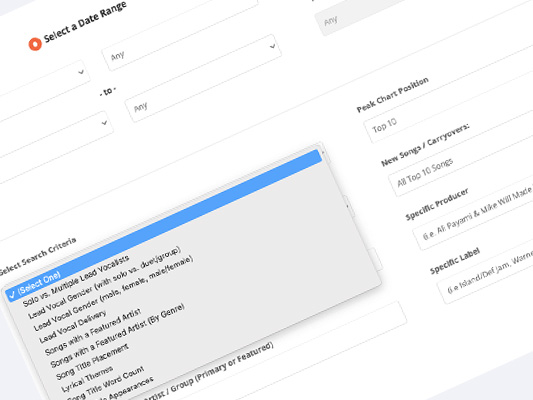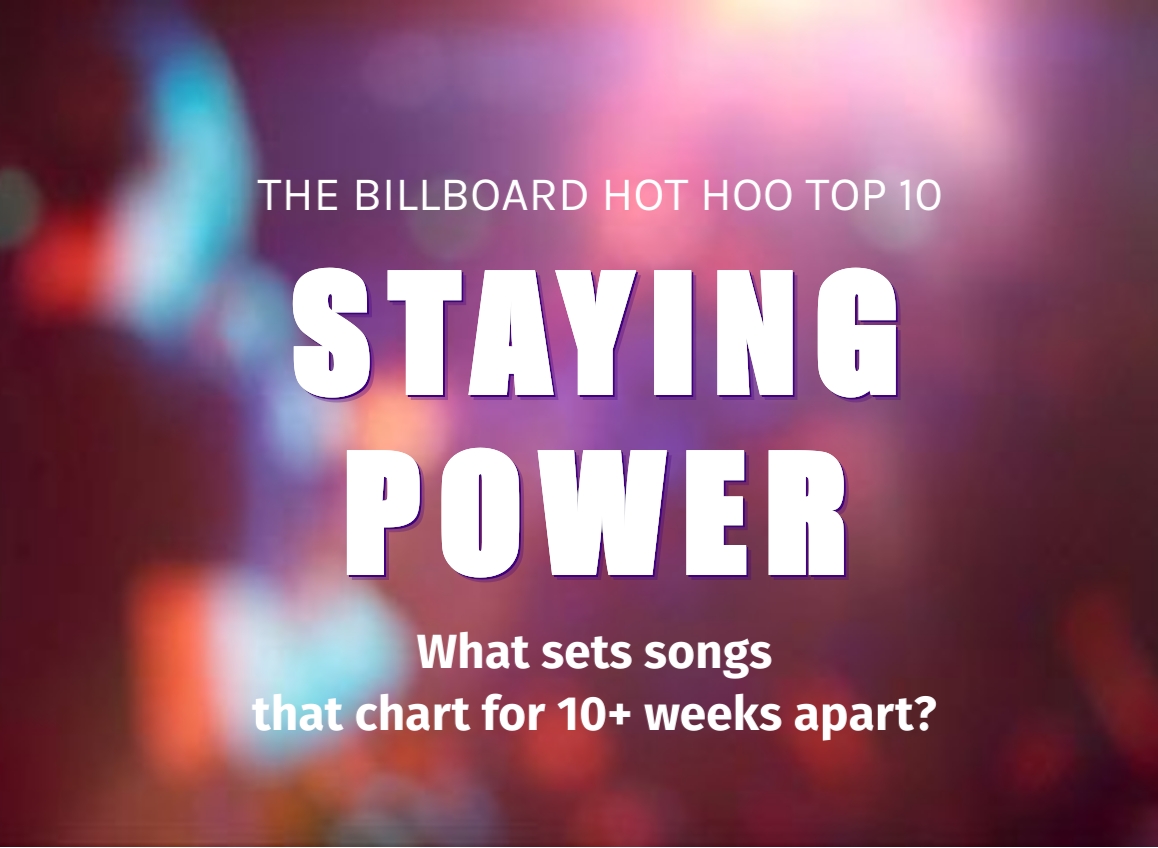A “D” section, which is the Hit Songs Deconstructed acronym for departure section, is the classification of a song section that provides a pronounced vocal, instrumental, lyrical and/or energy level departure compared to the rest of the song and generally appears around two-thirds to three-quarters of the way in. The most common types of “D” sections found in today’s hits are a bridge, which is by far most popular, a one-off vocal or instrumental break, or a diversified pre-existing section (i.e., verse, pre-chorus, etc.) compared to how they previously appeared in the song.
In lieu of the much more common bridge, Olivia Rodrigo’s “bad idea right?” goes against the grain with its highly atypical, high-energy instrumental break “D” section (the song is the only Hot 100 Top 10 hit to feature one in the first three quarters of 2023). While the guitar solo focus provides engaging variation compared to the other song sections, familiar material is included as well to heighten familiarity and memorability.
“D” Section Lead Up
Following the intro, “bad idea right?” traverses through two similar verse – pre-chorus – pre-chorus – chorus progressions (note that the song atypically contains two diverse back-to-back pre-choruses), followed by a brief four-bar turnaround. Consisting of bursts of drums, guitar and chorus vocal intensity broken up by partial breakdowns of highly effected guitar acrobatics and a low-level bass hook, the turnaround’s jarring quality effectively sets the stage for the instrumental break “D” section that follows. Occurring at 70% of the way into the song, this is right where one would expect to find it.

Stanza 1 “D” Section (Bars 1-8)
The first 8-bar segment of the 16-bar instrumental beak “D” section provides a notable departure in the scope of the song with its wild, highly effected guitar solo, which is more in line with late 1970s/early 1980s Devo and 1990s Nirvana than any of today’s mainstream hits. As a result, it accentuates the song’s overt alt/indie/new wave rock vibe and bolsters its ability to stand out in today’s mainstream music scene.
Supporting the solo is the high energy accompaniment from the chorus, which is now focused in a mid-frequency range as opposed to its notably brighter qualities as featured in the chorus. This was an important decision to allow the guitar solo to further pierce through the mix and connect on a more profound level.
Included in the accompaniment is the familiar guitar hook pattern that has been in effect across the entire song save for pre-choruses 1 and 3. In addition to heightening familiarity and getting further ingrained in the listener’s head, the quality of the hook pattern, which is highly reminiscent of Steve Miller’s 1969 hit, “Space Cowboy,” along with the accompaniment’s 1990s alt/rock qualities, cleverly fosters familiarity with older audiences as well, resulting in broadened reach and connectability (i.e., something that would appeal to the song’s young target demographic as well as their parents [1980s/1990s] and their parent’s parents as well [1960s/1970s]).
Note that while the guitar solo focus would have worked fine as the sole centerpiece of the first segment, Rodrigo and her co-writer and producer Dan Nigro saw a prime opportunity to further reinforce the catchy chorus vocals as well, but in a new context to avoid redundancy. Strategically appearing in bars 4 and 8, which are the stanza’s midway and ending points, the two most notable lines of the chorus, “the biggest lie I ever said” and especially, “I just tripped and fell into his bed,” are featured. Note that their similar placement in bars 4 and 8 of the chorus creates structural familiarity with the instrumental break, while their positioning leaves ample time for the guitar solo to shine.
Stanza 2 “D” Section (Bars 9-16)
With the high energy accompaniment providing cross-stanza continuity, stanza 2 changes up the lead guitar to heighten interest while still maintaining the vibe. Consisting of a 2x repetition of a three-segment pattern that rises in pitch with each subsequent iteration, it provides a focused build in intensity that perfectly complements the clever reprise of the similarly structured pre-chorus lines 1 and 2 vocals. Note that the vocal is more distant in the mix compared to its pre-chorus appearance, which is warranted so that it doesn’t compete with the guitar and allows the continuation of the notable chorus vocals to take center stage.
In the last two beats of the section, all the accompaniment elements are pulled save for some remaining guitar feedback. This provides another jarring moment that enables the song-defining standout statement, “I just tripped and fell into his bed,” to further standout and connect while transitioning into the outro that follows.
Subscribers can read this technique and an array of others in the Hit Songs Deconstructed Technique Library here.
Not a subscriber? Click here to sign up today!
EMPOWER YOURSELF
with interactive resources and tools that
support your creative process and help you compete at the highest level.
SPECIAL OFFER: Save 15% off Hit Songs Deconstructed!
Use discount code "CREATE" to save 15%.
Used By:












“
I find the site VERY valuable. I’m a fan.
Eric Hurt
VP, A&R Publishing / Nashville at EMPIRE
“
Spot on with the analysis and relevant to any music theory, composer, songwriter, or producer in the game now.
- Dr. O
Producer, Young M.A., Chris Brown, Lil Wayne
“
"Even though I’ve been writing professionally for over ten years, I’ve found several nuggets of gold that have improved my writing already."
Roy Stride
Hit Songwriter, Producer, Artist
One Direction, 5 Seconds of Summer, Scouting for Girls
“
My entire thought process as a producer, an engineer, a musician, and a songwriter are fleshed out in the pages of the HSD reports.
Prince Charles Alexander
Grammy winning, multi-platinum music producer, mixing engineer
and professor at Berklee College of Music
“
Some producers have a hit or two by sheer fluke/talent and the subconscious knowledge of a lifetime of growing up with music. However, making hits songs consistently is not just about talent and the occasional fluke. There is a science to the art of making hit music.
Hit Songs Deconstructed will equip you with tools that will allow you to make hit songs more consistently.
Lyburn Geldenhuis
A&R/Producer/Songwriter/Mixing Engineer
“
ASCAP aims to provide members with a multifaceted toolchest to augment their craft and their careers. Hit Songs Deconstructed is a cutting-edge service that can support our members' creative process with in-depth data and analysis of current songwriting techniques.
Nick Lehman
ASCAP Chief Strategy & Digital Officer
What Does a Pro Subscription Include?


Hit Song Deconstructions
A Library of 60+ Hit Songs Deconstructed Reports
The Hit Song Deconstructed reports provide unparalleled analysis of today's hits.
Each deconstruction breaks down a current hit to its foundational building blocks and pulls back the curtain on the patterns and science behind how the song was written, produced and arranged.
Leaving no stone unturned, everything is presented in a clear and concise manner and is complimented with unique Hit Songs Deconstructed visualizations that can be used to assess your own songs for strengths and weaknesses as well.
Among them are the HSD melodic parts tables and graphs, rhyme scheme tables, narrative structure tables, energy graphs, and more.
Each report is published in ten segments every two weeks, and analyzes structure, genres and sub-genre fusion, instruments and arrangement, energy and dynamics, vocal melody, vocal production, lyrics, and rhymes. The last segment features a top 10 benchmark and highlights the most important report takeaways.
By reading these deconstructions, you'll become privy to the same tools and techniques today's hitmakers are using.
The insight you'll gain will take your craft to the next level, guaranteed.
Downloadable DAWs
A visual roadmap for understanding how today's hits are arranged.
Every Hit Song Deconstruction includes a downloadable DAW project (Logic).
Using empty MIDI regions to visualize the instrumental arrangement, energy, vocal melody and production, structure, select techniques and more, these DAW projects provide you with a visual roadmap for understanding how today’s hits were effectively arranged.
By watching as you listen, you will gain valuable insight into the strategic decisions today’s hitmakers made to help prime their songs for maximum impact, giving you a host of new tools, techniques, and ideas to help take your own songs to the next level.

Fuel Your Inspiration with a Library of 100+ Hit Song Techniques
Hit-Scope: A Searchable Library of Songwriting Techniques
Fuel your inspiration with the techniques that helped today’s most successful songs become global hits!
This extensive collection houses examples of the most effective techniques found in Hot 100 top 10 hits spanning various genres.
Every Tuesday, you’ll receive an expertly curated technique that has been deconstructed by the Hit Songs Deconstructed team to study. Each technique is accompanied by a detailed explanation, visual aids, and audio clips revealing the what, the why, and the how behind them.
It's the perfect way to continuously hone your craft and incorporate techniques from current chart-toppers into your own music.
Techniques include: Hook Techniques, Intro Techniques, Outro Techniques, Duet/Group Lead Vocal Structure Techniques, Audience Participation Moment Techniques, Energy Techniques, Section Impact Accentuator Techniques, Sub-Genre Fusion Techniques, Chorus Vocal Structure Techniques, Departure Section Techniques, Prosody Techniques, and Rhyme Techniques (with more technique categories to come!)
Hit Song Search
200+ filters to find the exact song you are looking for with the click of a button.
Need reference tracks? Mix and match 200+ compositional filters to find Hot 100 Top 10 songs with very specific compositional characteristics.
In addition, this tool can be used to:
- See how your song stacks up against proven hits with similar compositional characteristics
- Get insight for ways to take your song to the next level and/or give it a unique spin
- Understand the space you are looking to compete in
- Or simply get inspired!


Search Filters include:
Unlike AI-Powered analytics, each song is manually analyzed and every data point is vetted in accordance with HSD's proprietary methodologies for accuracy.
Compositional Analytics
Round out your toolbox with songwriting analytics for today's most successful songs.
Looking for insight into what today's hits have in common? Or want to spot trends on the rise, or in decline? Or need to back up gut feelings with factual data?
This powerful, fully interactive database provides you with critical insight into how the current musical landscape is evolving with valuable, real-time intelligence on the compositional characteristics of the songs that land in the Top 10 of the Billboard Hot 100.
Hundreds of different searches keep you in tune with what’s driving the Hot 100 Top 10 at the compositional level. Trends are visualized with graphs and tables with each data point linking to a list of the corresponding songs.
Search for trends pertaining to primary genres, sub-genres/influences, instruments, lead vocals (gender, vocal delivery, etc.), lyrics (lyrical theme, title placement and appearances, etc.), song structure (key, tempo, song length, song form, etc.), song sections (intro characteristics, first chorus occurrence, post-chorus types, etc.), and much more.
Save your most important searches to your dashboard for easy access!

Benchmark Tool
Compare and contrast compositional characteristics across songs, artists, songwriters, producers and labels.
This powerful tool gives you the ability to compare and contrast any of the compositional characteristics in The Immersion Database across songs, artists, songwriters, producers and labels.
- Gain insight into a specific body of work of a particular artist, songwriter, producer or label
- Understand what compositional characteristics a select group of songs have in common
- Discover how songs stand out from the pack by going against the grain
- Make targeted pitches by researching what creates the signature sound of a particular artist, producer, or songwriter

Trend searches include number of songs in the Top 10, weeks in the Top 10, trends for featured artist, genre breakdown, team size, and more.
Searches can be filtered in a multitude of ways including by date range, primary genre, peak chart position, among others.
All search results include links to the corresponding songs and profile pages.
Artist, Songwriter, Producer and Label Database
Stay in tune with the artists, writers, producers, and labels behind today’s hits and the trends behind them.
Every artist, songwriter, producer and label has its own personal profile detailing which artists, songwriters, producers and labels they’ve collaborated with, their compositional profile, charting information and a link to their Twitter and Instagram pages.

Hit Songs Deconstructed Trend Reports
The State of the Hot 100 Top 10 Delivered to Your Inbox
Today’s hits are changing faster than ever, from the songwriting and production techniques used to craft them to the influences and instruments shaping their sound. To stay ahead of the curve, it's critical to proactively stay on top of what's driving today’s most successful songs at the compositional level. The Hit Songs Deconstructed trend reports deliver an easy-to-digest snapshot of the trends driving the Hot 100 top 10.

This report delivers an in-depth look at trends for all the compositional categories we track, including primary genres, sub-genres, lead vocals, lyrical themes, instruments, key, tempo, song length, song structure, and much more.

A deconstruction of the compositional characteristics that are unique to #1 hits.

A deconstruction of the compositional characteristics that are unique to songs that chart for 10+ weeks in the top 10..
“
I can't stress enough how important HSD is to any serious professional hit songwriter.
Hilton Wright II
Record Producer/Songwriter
“
As a songwriter, an important part of my job is to analyze what works in successful songs. By identifying the tools that were employed in hits, writers can incorporate them into their own songs--using techniques that have proven successful--while putting their own spin and unique creative angle on them. HSD does the research for me.
- Jason Blume
Songwriter w/50 million album sales and top-selling author, Billboard Books
“
I am honestly blown away by the amount of information you provide on each of these songs, practically like a thesis deserving of a degree. From a songwriting standpoint, so much of this information is so helpful, and the time-saving benefits are enormous.
- KC Porter
Grammy winning producer/songwriter/recording artist
Carlos Santana, Ricky Martin, Ozomatli, Boyz II Men, Selena


